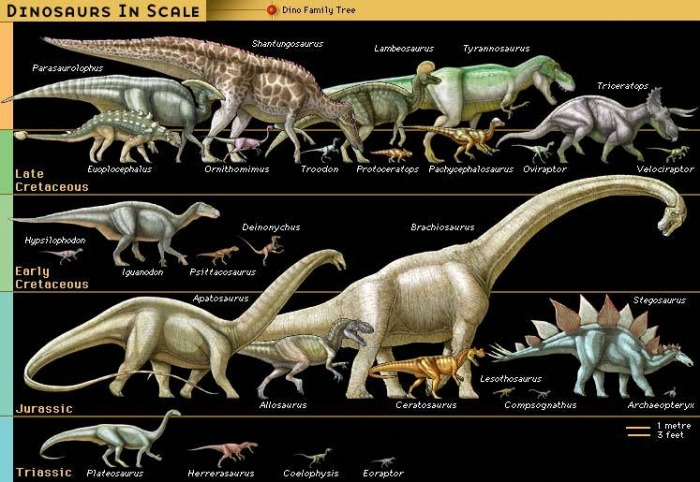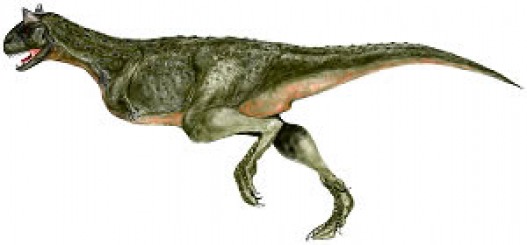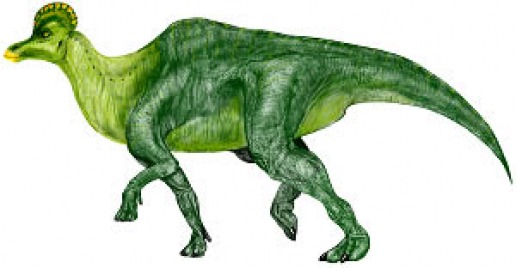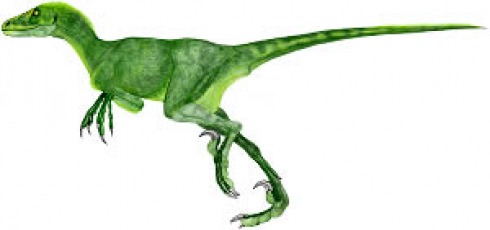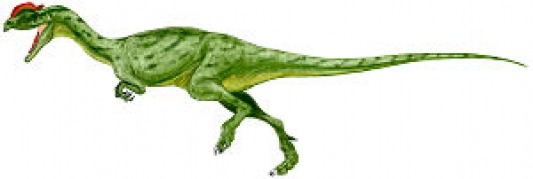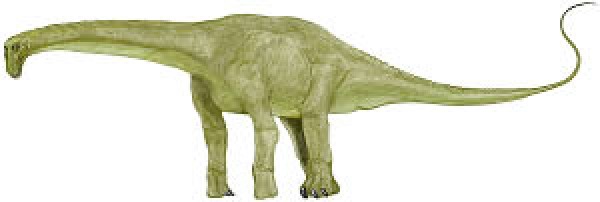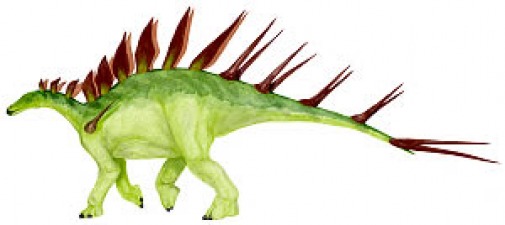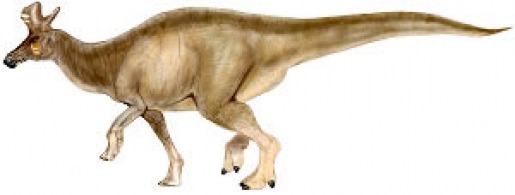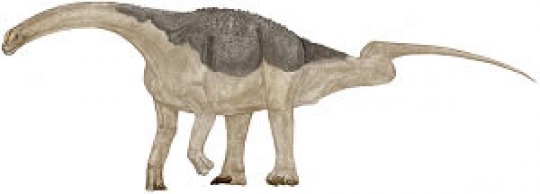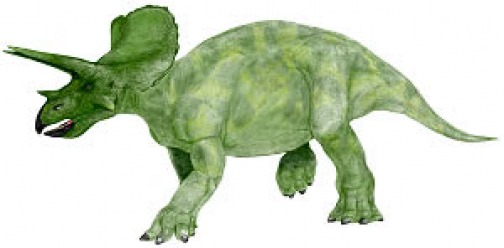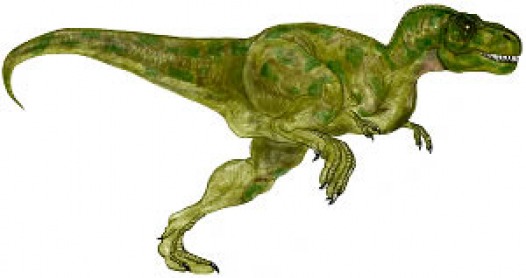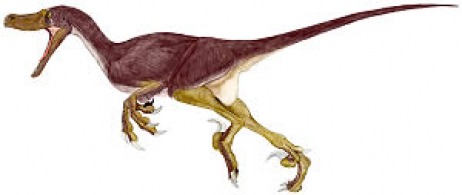Denizens of Pangaea
The variety of dinosaurs that a player can encounter in the world of AoR is rather large and diverse. Keeping in mind that the creator of the Age of Reptiles stories drew on species that spanned over millions of years, the AoR mud also draws on dinosaurs that, in actuality, may never have existed together. While accuracy may not be met in this particular area, most species in the game will have originated from the Jurassic or Cretaceous period and, for the most part, such discrepancies do not prevent the experience from meshing.
BRACHIOSAURUS
"Arm Lizard"
One of the largest, tallest dinosaurs, about 82 feet long, 52 feet high
and weighing 50 tons: a massive four-footed plant-eater with nostrils
high on the head, long 'giraffe neck,' longer forelimbs than hindlimbs,
and short tail.
FAMILY: Brachiosauridae.
ERA: Late Jurassic ( Kimmeridgian - Tithonian 154.1 - 144.2 Ma ), and early
Cretaceous ( Albian 112.2 - 98.9 Ma ).
SIZE: Length 23 - 30m (75 - 100ft). Shoulder height 6m (20 ft). Head height 12m
(39 ft). Weight ?30 -80 tonnes.
LOCATION: North America , Africa , Europe.
FOSSILS: B. altithorax; Partial skeletons from 2 individuals.
B. brancai; 5 partial skeletons, at least 3 skulls, limb elements.
B. atalaiensis; Vertebra e, ischia , pubes , limb elements.
B. nougaredi; Sacrum , forelimb elements.
COMMENTS: The eyes and nostrils of Brachiosaurus were set high up on the dome
on its head, and the skull had many holes to lighten its weight. The airways
in the skull have suggested to some that it may have had a trunk, but this
theory is not widely supported. Like most sauropods it probably travelled in
herds.
CARNOTAURUS
(Flesh eating bull)
FAMILY: Abelisauridae.
ERA: Mid Cretaceous ( Albian - Cenomanian 112.2 - 93.5 Ma ).
SIZE: Length 8 m (27 ft). Weight 1 tonne.
LOCATION: South America.
FOSSILS: Complete skeleton and skull.
COMMENTS: The skull of Carnotaurus is unusual for its deep shape and the horns
just above the eyes. The 4 digits on each hand are a primitive feature (most
carnosaurs had 2 or 3), and the forearms, not much longer than the fingers,
were even shorter than in Tyrannosaurus, and did not bend, as they were formed
from the upper arm bones only. Its skin was covered with 4-5 cm (2 in)
diameter bumps in rows about 8-10 cm (4 in) apart, becoming larger towards the
spine. Each bump was surrounded by 5mm (1/5 in) tubercles. Skin impressions
representative of nearly the entire body length have been found, giving
scientists their best information on dinosaur skin. Its long, muscular back
legs probably made it more agile than the carnosaurs.
COMPSOGNATHUS
Compsognathus (komp SOG nuh thuhs) was one of the smallest known dinosaurs. It grew to about the size of a chicken or turkey, measuring around 2.5 feet long and weighing about 6 to 7 pounds. The animal lived from 155 million to 145 million years ago, during the Late Jurassic Period. Compsognathus had a light but powerful body with long legs, birdlike feet and short arms. Two fingers on each hand ended in powerful claws. The dinosaur was agile and could run quickly on its hind legs, using its long tail to provide balance. Compsognathus also had an elongated, flexible neck and a narrow, pointed head. Its name means elegant jaw in Greek. Like modern birds, Compsognathus had hollow bones.
FAMILY: Compsognathidae .
ERA: Late Jurassic ( Kimmeridgian 154.1 - 150.7 Ma ).
SIZE: Length 0.6 m (2 ft). Weight 3 Kg (6.5 lb).
LOCATION: Europe.
FOSSILS: 2 skulls and associated postcrani al skeletons.
COMMENTS: Compsognathus is one of the smallest known dinosaurs. The tail was as
long as the rest of the body. Although tiny, it was extremely fast. The
Bavarian specimen contained the remains of 10 eggs in the body cavity, and the
skeleton of the small lizard Bavarisaurus in the stomach area.
SPECIES LIST:
C. longipes Wagner, 1859 (type) includes C. corallestris Bidar, Demay and
Thomel, 1972. Some workers maintain that these are 2 separate species .
C. prima Ji, Q. and Ji, S., 1996/Morell, 1997 is a junior synonym of
Sinosauropteryx.
CORYTHOSAURUS
Corythosaurus was a large, plant-eating, duck-billed dinosaur (family Hadrosauridae). It was 10-33 feet (3-10 m) long, up to 6.6 feet (2 m) tall at the hips, and may have weighed up to 5 tons. It had a hollow, bony crest on top of its long head in the shape of a helmet flattened on the sides (Corythosaurus means "helmet lizard"). Corythosaurus' nostrils went up through the crest. The crest may have been used to make sounds, as a cooling device, courtship displays, and/or as a sense-of-smell enhancer (Corythosaurus' olfactory lobes, the part of the brain that sense smell, were located within the crest). Males had larger crests than females and juveniles. Corythosaurus had a toothless beak and hundreds of cheek teeth that it used to grind up its food. It walked on two legs (or four), had shorter arms, and a long, heavy tail. It had no natural defenses.
(Helmeted reptile)
FAMILY: Hadrosauridae.
ERA: Late Cretaceous ( Campanian 83.5 - 71.3 Ma ).
SIZE: Length 10 m (33 ft). Weight 3.8 tonnes.
LOCATION: North America.
FOSSILS: 10 articulated skulls and associated postcrani a.
COMMENTS: This lambeosaurine had a deep crest like a cocked hat on its head
with complex air passages. The young and females had small crests.
DEINONYCHUS
Deinonychus (dy NON ih kuhs) was a relatively small, meat-eating dinosaur. It grew about nine feet long, stood about five feet tall and weighed about 150 pounds. It walked and ran on two hind legs, using its long stiff tail
for balance. Deinonychus had a body well suited for hunting. The animal's head had large eyes, powerful jaws, and sharp serrated (saw-edged) teeth. Its teeth curved backward and could easily chew up prey. The dinosaur also had elongated arms and long, slender fingers to grasp its victims. On each foot grew a long bladelike claw, which Deinonychus used to tear prey apart. These claws measured about 5 inches (12.5 centimeters) in length.
They give the dinosaur its name, which means terrible claw. Deinonychus probably hunted in packs to kill larger animals.
Unlike the factual dinosaur, however, the Deinonychus of AoR have personalities
and rudimentary thought patterns. Though somewhat simple and primitive, they
possess the ability to form plots and plans, recognize eachother and other
dinosaurs as individual beings, and have feelings, albeit of a limited scope.
In the comic series, they are shown gesturing, pantomiming recent events and
displaying emotions. Revenge is far from being beyond their capacity.
Use these ideas as a player and form a unique individual from your character,
however keep in mind that Deinos do *not* sit around "chatting" and making
smalltalk, use or make tools, comprehend higher sciences or truly behave as
a human would. Seeing a disliked packmate eaten by a T-Rex can be "laughed" at
but no Deino would even attempt to tell a joke in any manner. Survival is
every character's priority, so hunting, mating and seeking power within one's
pack is tantamount to all other things.
DILOPHOSAURUS
(Two crested or ridged reptile)
Coelophysoidea.
ERA: Early Jurassic (? Sinemurian - Pliensbachian 201.9 - 189.6 Ma ).
SIZE: Length 6 m (20 ft). Weight 300 - 450 Kg (770 - 990 lb).
LOCATION: North America , Asia.
FOSSILS: D. wetherilli; 2 subadult skeletons, partial skeleton, fragments.
D. sinensis; Nearly complete skeleton.
COMMENTS: Dilophosaurus had long, powerful legs and short arms, and 2 thin,
highly arched nasolacrymal crests on its head for display. It may have been a
scavenger , as its jaws were not well developed. The Chinese species' crests
were higher and thicker.
DIPLODOCUS
"Double Beam"
Immensely long four-legged plant-eater with low, sloping head, snaky neck,
slim limbs, and finely tapered whiplash tail. One of the longest dinosaurs, up to 87 feet 6 inches long, yet weighing 12 tons or less.
FAMILY: Diplodocidae.
ERA: Late Jurassic ( Kimmeridgian 154.1 - 150.7 Ma ).
SIZE: Length 27 m (88 ft). Weight 10-11 tonnes.
LOCATION: North America.
FOSSILS: D. longus; 2 skulls, series of caudal vertebra e.
D. carnegii; 5 skeletons, 2 skulls, postcrani al elements.
D. hayi; Partial skeleton with braincase .
D. lacustris; Jaw with teeth.
COMMENTS: One of the longest land animals ever known, although now outranked by
giants such as Seismosaurus, Argentinosaurus and others, Diplodocus gets its
name from the middle tail bones which had fore and aft bony skids that
protected the blood vessels if its tail dragged on the ground. A new 1990 find
of skeleton and skin impressions indicated that it (and possibly other
sauropod s also) had a row of spines down its back.
IGUANODON
"Iguana Tooth"
Large bipedal/quadrupedal plant-eater up to 29 feet 6 inches long and
weighing up to 5 tons, with toothless beak, tight-packed, ridged cheek
teeth, hooflike claws, and spiky thumbs. One of the most wide-spread and
prolific of dinosaurs.
FAMILY: Iguanodontidae.
ERA: Early Cretaceous ( Valanginian - Albian 137 - 98.9 Ma ).
SIZE: Length 9.5 m (32 ft). Height 5m (16 ft). Weight 4.5 tonnes.
LOCATION: North America , Europe , Asia.
FOSSILS: I. anglicus; Teeth and postcrani al fragments.
I. atherfieldensis; 3 complete skulls and skeletons, partial skeletons,
teeth, postcrani a, juvenile to adult.
I. bernissartensis; At least 26 skeletons and skulls, partial skeletons,
teeth.
I. dawsoni; Dorsal vertebra , pubis , ilium .
I. fittoni; 3 partial skulls and jaws, ilium .
I. hoggi; Mandible with teeth.
I. lakotaensis; Skull, mandible , vertebra e.
COMMENTS: Iguanodon was named from its teeth that resembled larger versions of
those of modern iguana lizards. It was a herbivore with an elongated
horse-like head, rows of grinding teeth, and may have had a long tongue. It
lived in herds near lakes in warm swampy country, and was the biggest, most
plentiful and most widespread iguanodontid. It could move quickly if
necessary. The first species was found in 1822 and was only the second
dinosaur to be named.
KENTROSAURUS
(Prickly or pointed reptile)
Stegosauria.
ERA: Late Jurassic ( Kimmeridgian 154.1 - 150.7 Ma ).
SIZE: Length 2.5 - 5 m (8 - 16 ft). Weight 450 Kg (1000 lb).
LOCATION: Africa.
FOSSILS: 2 composite mounted skeletons, braincase s, sacra , femora , isolated
elements.
COMMENTS: Kentrosaurus had a spiky tail, pairs of short triangular plates on
its neck and shoulders, and long spikes on its back and tail. It may have
given rise to later stegosaurids. It was first discovered in 1909.
LAMBEOSAURUS
(Lambe's reptile)
FAMILY: Hadrosauridae.
ERA: Late Cretaceous ( Campanian 83.5 - 71.3 Ma ).
SIZE: Length 15 m (50 ft).
LOCATION: North America.
FOSSILS: L. lambei; 7 articulated skulls and postcrani a, about 10 articulated
skulls, juvenile to adult.
L. magnicristatus; 2 complete skulls, 1 with postcrani a.
L. laticaudus; Isolated skull and postcrani al elements.
COMMENTS: This lambeosaurine had a hollow hatchet-shaped crest (sometimes
bigger than the skull itself) jutting forward from skull roof, and a spine
jutting back, perhaps supporting a neck frill. The animal's air passages
continued through the crest, for unknown reasons.
OVIRAPTOR
"Egg Thief"
Birdlike predator or herbivore about 6 feet long, with short deep crested
head, short deep beak with two teeth in mouth roof, strong arms, long legs,
curved claws on its three-fingered hands and three-toed feet, and heavy tail.
FAMILY: Oviraptoridae.
ERA: Late Cretaceous ( Santonian - Maastrichtian 85.8 - 65 Ma ).
SIZE: Length 1.8 m (6 ft). Weight 25 - 35 Kg (55 - 77 lb).
LOCATION: Asia.
FOSSILS: 3 specimens, skulls, complete postcrani a, partial postcrani a.
COMMENTS: Oviraptor's lower jaw curved up and was shaped to help exert strong
crushing force. It had clawed, grasping hands, with the largest claw on the
3rd finger (8cm/4 in long). Its feet had 4 toes, the first tiny and useless,
and the rest clawed. It had large eyes and head crest, and unusual shoulder
bones that resembled a bird's wishbone. Originally it was categorised as a
stealer of eggs, but new evidence indicates that the original specimen was not
stealing Protoceratops' eggs but incubating its own (the embryo in the egg is
an Oviraptor), and another specimen has been found in a characteristic
hatching posture on a nest with several clutches of eggs.
PARASAUROLOPHUS
(near Saurolophus)
FAMILY: Hadrosauridae.
ERA: Late Cretaceous ( Campanian - Maastrichtian 83.5 - 65 Ma ).
SIZE: Length 10 m (33 ft).
LOCATION: North America.
FOSSILS: P. walkeri; Complete skull and postcrani a.
P. tubicen; Disarticulated skull and postcrani a from at least 3
individuals.
P. cyrtocristatus; Fragmentary skull, isolated postcrani a.
COMMENTS: This lambeosaurine had a crest like swimmer's snorkel, with a curved
hollow horn up to 1.8m (6 ft) long with complex air passages, including
breathing passages that ran from nostril up one side of crest and down the
other side to the mouth. Possibly this was used to make loud bellowing noises,
or perhaps to enhance its sense of smell. It may have had frill from horn to
back. Its muzzle was relatively short.
SALTASAURUS
"Salta Lizard"
First known armored sauropod: a four-legged plant-eater 40 feet long, with
long neck and tail and bulky broad-backed body protected by bony plates
and hundreds of bony studs.
FAMILY: Titanosauridae.
ERA: Late Cretaceous ( Campanian - Maastrichtian 83.5 - 65 Ma ).
SIZE: Length 12 m (39 ft).
LOCATION: South America.
FOSSILS: S. loricatus; Partial skeletons of about 6 individuals, jaws and
armour.
S. robustus; Vertebra e and limb elements of 3 individuals.
COMMENTS: This was the first armoured sauropod discovered - it had hundreds of
bony studs on its back and sides. It had a flexible tail and may have reared
up on its back legs to reach leaves in tall trees. Its broad back, and strong,
broad upper tail bones may have enabled the tail to be used as a prop at
times. It also had a few bony plates for protection on its back. It is named
after Salta in Argentina where it was first found in 1970.
TRICERATOPS
"Three Horned Face"
Longest horned dinosaur: a four-legged plant-eater up to 30 feet long and
weighing 6 US tons, with a short tail and bulky body. The massive head
had a deep narrow parrotlike beak, brow horns more than 3 feet long, a short
nose horn, and short short solid neck frill rimmed with bony bumps.
FAMILY: Ceratopidae.
ERA: Late Cretaceous ( Maastrichtian 71.3 - 65 Ma ).
SIZE: Length 9 m (30 ft). Weight 5.4 tonnes.
LOCATION: North America.
FOSSILS: T. horridus; 50 complete or partial skulls, some partial skeletons.
T. prorsus; Skull.
COMMENTS: Triceratops was the longest ceratopid, and one of the last. It had a
skull 2m (6 ft) long and horns 1m long, (1 above each eye, 1 on its nose). The
neck frill was a saddle shaped, solid piece of bone. Its scissor-like teeth
were in rows so that as one wore out it was replaced by the next row. It was a
plant eater. Males may have fought for domination, while the frill probably
served a number of functions including display and heat regulation.
TYRANNOSAURUS
"Tyrant Lizard"
Tyrannosaurus is a genus of theropod dinosaur. The famous species Tyrannosaurus rex ('rex' meaning 'king' in Latin), commonly abbreviated to T. rex, is a fixture in popular culture around the world. It lived throughout what is now western North America, with a much wider range than other tyrannosaurids. Fossils of T. rex are found in a variety of rock formations dating to the last three million years of the Cretaceous Period, approximately 68 to 65 million years ago; it was among the last non-avian dinosaurs to exist prior to the Cretaceous–Tertiary extinction event.
Like other tyrannosaurids, Tyrannosaurus was a bipedal carnivore with a massive skull balanced by a long, heavy tail. Relative to the large and powerful hindlimbs, Tyrannosaurus forelimbs were small, though unusually powerful for their size, and bore two primary digits, along with a possible third vestigial digit. Although other theropods rivaled or exceeded T. rex in size, it was the largest known tyrannosaurid and one of the largest known land predators, measuring up to 13 meters (43 ft) in length,up to 4 meters (13 ft) tall at the hips,and up to 6.8 metric tons (7.5 short tons) in weight.By far the largest carnivore in its environment, T. rex may have been an apex predator, preying upon hadrosaurs and ceratopsians, although some experts have suggested it was primarily a scavenger.
More than 30 specimens of T. rex have been identified, some of which are nearly complete skeletons. Soft tissue and proteins have been reported in at least one of these specimens. The abundance of fossil material has allowed significant research into many aspects of its biology, including life history and biomechanics. The feeding habits, physiology and potential speed of T. rex are a few subjects of debate. Its taxonomy is also controversial, with some scientists considering Tarbosaurus bataar from Asia to represent a second species of Tyrannosaurus and others maintaining Tarbosaurus as a separate genus. Several other genera of North American tyrannosaurids have also been synonymized with Tyrannosaurus
VELOCIRAPTOR
(Swift plunderer)
FAMILY: Dromaeosauridae.
ERA: Late Cretaceous ( Santonian - Campanian 85.8 - 71.3 Ma ).
SIZE: Length 1.8 m (6 ft).
LOCATION: Asia.
FOSSILS: More than 6 partial to complete skulls and skeletons.
COMMENTS: Velociraptor ate small reptiles and mammals, although one was found
that died fighting a Protoceratops. It had a long, low head, a depressed
muzzle, relatively large brain, and small, sharp teeth. It was fast and
intelligent.
SPECIES LIST:
V. mongoliensis Osborn, 1924 (type) including Ovoraptor djadochtari.
V. antirrhopus Ostrom, 1969/Paul, 1987 is a junior synonym of Deinonychus.
V. langstoni Sues, 1978/Paul, 1988 is a junior synonym of Saurornitholestes.
